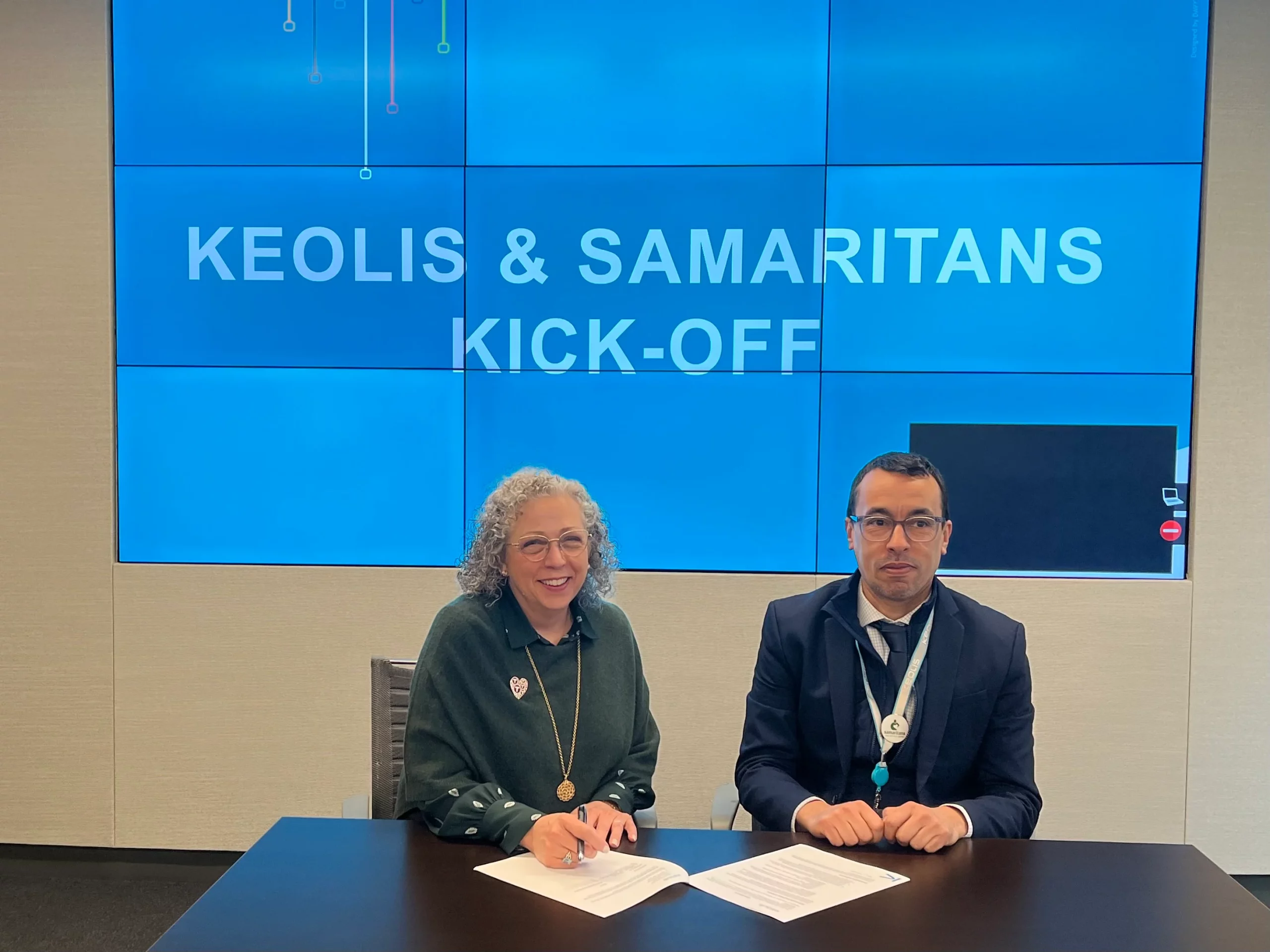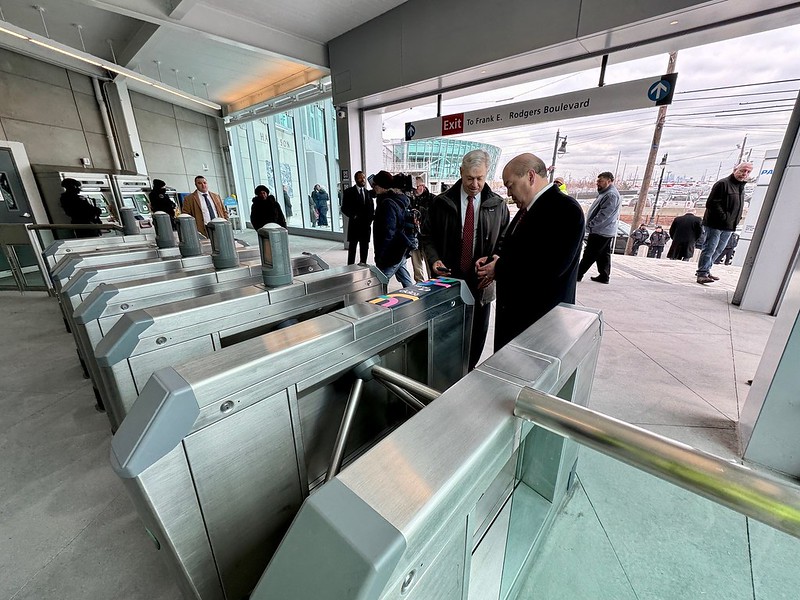
Transit Briefs: Keolis, PANYNJ, Project Connect
Written by Carolina Worrell, Senior Editor
(Keolis)
Keolis Commuter Services (Keolis) expands its partnership with Samaritans to provide lifesaving trainings to Commuter Rail personnel. Also, the Port Authority of New York and New Jersey’s (PANYNJ) new PATH commuter rail tap-and-go payment system is now available at select turnstiles in all terminal stations; and a court challenge from Texas Attorney General Ken Paxton could end Austin’s Project Connect plans.
Keolis
Keolis on March 20 announced an expanded partnership with Samaritans, a provider of lifesaving suicide prevention services throughout Massachusetts, to facilitate mental health and suicide prevention training to Commuter Rail frontline personnel.
Throughout the second quarter of 2024, Samaritans will develop the training program, including the facilitation of focus groups, stakeholder interviews, and training materials for frontline employees at Keolis. The launch of training is set to begin in the third quarter of 2024 and conclude within 2025.
“We are proud of our longstanding partnership with Samaritans, and we are excited to collaborate with them to provide our workforce with training and resources on suicide prevention,” said Keolis CEO and General Manager Abdellah Chajai. “Our frontline workers at Keolis interact with thousands of people every day and this training will give them the tools they need to help someone who may be in crisis. If through this training we can help save just one life, that will already be a success.”
“Our ultimate goal is to create a safer and more supportive environment for everyone,” said Samaritans CEO and President Kathleen C. Marchi. “This partnership marks a significant step forward in providing essential mental health and suicide prevention training to Commuter Rail frontline personnel. By empowering these workers to take care of their own mental health and equipping them with the skills to recognize and respond to mental health crises, this project will undoubtedly save lives.”
Through the mental health and suicide prevention training program, Samaritans will educate Keolis frontline employees on the topic of mental health, including identifying people at risk, developing strategies for engaging with a person in crisis, whether a colleague or a member of the public, and connecting someone in need with mental health resources.
“Mental health training is essential for creating supportive environments where individuals feel comfortable seeking help and support,” said Samaritans Chief Clinical Officer Kacy Maitland. “Through this program, Commuter Rail personnel will gain valuable insights into identifying signs of distress, communicating effectively with individuals in crisis, and connecting them with appropriate resources. These skills are not only critical for intervening in potential crises but also for fostering a culture of empathy and compassion.”
According to Keolis, Samaritans will interview employees and key stakeholders to tailor the program to the specific needs of the Massachusetts Bay Transportation Authority’s (MBTA) Commuter Rail operator, developing a series of training modules that teach Commuter Rail personnel the skills to deescalate situations they may encounter in their work.
Keolis Commuter Services has been a partner with Samaritans since 2014, sponsoring the Samaritans Breakfast for Hope and 5K Run/Walk for Suicide Prevention to honor those who have been lost, support those who are struggling and raise money for suicide prevention. Through this partnership, Keolis has collaborated with Samaritans to host in-station resource tables that share lifesaving mental health information with Commuter Rail riders and continues to feature signage across Keolis’s network that highlights and educates the riding public on the national 988 Suicide and Crisis Lifeline.
PANYNJ
PANYNJ on March 20 announced that the Total Access PATH Payment (TAPP) system has now been expanded to the five terminal stations in the PATH system, allowing passengers to pay their fairs at select turnstiles with the tap of a contactless debit/credit cart, smartphone, or wearable device. The first phase of the rollout is being completed this week with the installation of 12 TAPP turnstiles at the World Trade Center (WTC), the system’s busiest station.
According to PANYNJ, PATH has recorded more than one million TAPPs since the system’s launch in December 2023, “indicating a quick and seamless adoption by riders.” On an average weekday, PANYNJ says nearly 20,000 TAPPs are recorded among passengers entering the PATH system.

“These TAPP numbers show we’ve tapped into something our riders truly appreciate, giving them more flexibility and more freedom in how they pay their fare,” said PANYNJ Chairman Kevin O’Toole. “The first phase of the TAPP rollout has been a resounding success, and we’re excited to bring this technology to the rest of the system in the near future.”
“We’re delighted to see the rapidly growing number of PATH riders tapping into the new fare payment system and the convenience it offers,” said PANYNJ Executive Director Rick Cotton. “Bringing a 21st century tap-to-pay fare system to PATH is an important part of our much broader effort to make every element of this century-old railroad convenient and reliable for riders—modernizing equipment, renovating stations, and renewing infrastructure across the system.”
Following the installation of TAPP turnstiles at the WTC terminal, TAPP is now available through select turnstiles at terminal stations where PATH lines begin and end, as well as at Harrison Station. This includes WTC and 33rd Street terminals in New York, along with Newark-Penn Station, Journal Square, and Hoboken in New Jersey. These six stations, PANYNJ says, are the system’s busiest, accounting for 67% of total ridership in 2023. The TAPP rollout will move to the system’s remaining stations in New Jersey and New York over the coming months.
TAPP is an open-loop contactless payment system, which allows customers to use any contactless credit/debit card or the digital wallets in their own devices at PATH turnstiles, instead of specific PATH-issued SmartLink cards or pay-per-ride MetroCards. During phase-in and for a substantial period thereafter, equipment supporting SmartLink and MetroCard will remain operational as customers become familiar with the new system. New TAPP turnstiles will continue to be installed gradually throughout the system.
The PATH commuter rail system, PANYNJ says, continues to see consistent ridership growth. In 2023, the system served 50.5 million passengers, the highest ridership since pre-pandemic 2019. This was a 19% increase over 2022’s total passenger volume and 61% of 2019’s total.
Project Connect
Austin’s efforts to build a high-frequency urban rail network is facing a challenge from Texas AG Ken Paxton, whose legal arguments “seek to dismantle the funding mechanism behind the voter-endorsed transit expansion,” according to a report by The Texas Tribune.
According to the report, Paxton, in a court filing “slammed the city’s payment plan for the 10-mile light rail starter system,” known as Project Connect. The financial strategy, The Texas Tribune reports, was designed to navigate “the increasingly tight strictures the state Legislature has placed on how Texas cities raise money. If a court sides with Paxton, it could kill the light rail expansion project.”
In November 2020, Austin voters approved a 21% increase in the maintenance and operations portion of their property tax rate to fund the project. The tax hike generates about $166 million a year and growing, according to the report.

According to the report, the city transfers tax money to the Austin Transit Partnership (ATP), an entity authorized by voters to build and finance light rail. ATP, The Texas Tribune reports, “needs big loans to cover the high upfront construction costs. The tax cash helps ATP secure loans and then pay them off.”
The estimated price tag of $4.7 billion in 2022 dollars, The Texas Tribune reports, could reach $7.1 billion by the time construction starts, according to a draft financial plan in ATP’s application for federal grants. The estimate doesn’t include interest payments on debt.
Federal grants could cover up to half the costs of the light-rail system, ATP executives say. But the agency, The Texas Tribune reports, is planning to borrow some $1.75 billion in bonds to kickstart construction, which wouldn’t begin until 2027 at the earliest.
“The politically conservative Texas attorney general, who’s on track to be tried for felony fraud this spring, resurrected arguments he made in a legal opinion last year. Paxton said the maintenance and operations portion of a property tax bill can’t be used to pay down public debt,” according to the report.
“The City attempted to create a contract with the voters that … the Tax Code did not authorize,” Paxton said in the filing, calling the funding plan “void at the time of its original execution.”
Paxton’s filing, The Texas Tribune reports, comes as ATP is asking the state court to remove any doubt about the local government corporation’s ability to issue bonds. ATP and the city filed the so-called “bond-validation” lawsuit to “preemptively stop the attorney general from blocking the sale of bond debt, a power he has over local government corporations like ATP,” according to the report.
“It’s part of an effort to protect this voter-approved, generational light rail project for generations to come,” Mayor Kirk Watson said last month in his newsletter. “The statute includes an expedited timeline for the court to act so the litigation won’t drag on for years and years, imperiling the project.”
According to the report, if a court agrees with Paxton and finds ATP cannot borrow money, it could kill the light rail project, which is “exactly what a group of plaintiffs wants.”
“You are seeing the beginning of the end of the biggest con job ever perpetrated on the taxpayers of Austin,” said Bill Aleshire, an attorney representing plaintiffs in a separate suit over ATP’s power to borrow. “When all is said and done, I expect the final court decision to result in a rollback of the almost 21% Austin property tax increase being used to [fund] Project Connect and a refund of hundreds of millions of those dollars that ATP has on hand, unspent,” Aleshire said in an email.
Lawyers with ATP and the city, The Texas Tribune reports, “are poring over Paxton’s filing and plan to fire back.”
“The city recently received the AG’s pleading,” city spokesperson Michele Gonzalez said in a statement. “We disagree with the AG’s assertions and are certain the court will allow the City and ATP time to file responses.”



